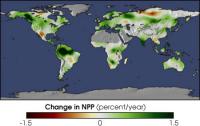-
Addressing global food system challenges
Agriculture now produces more than enough calories to meet basic human dietary needs worldwide. Despite this seeming abundance, one out of eight people do not have access to sufficient food. A new study presents a set of strategies to address these complex challenges of producing food for a growing global population, while reducing environmental impacts and increasing resilience in the face of climate change.
-
-
Mapping water use of America’s water resources
Water is one of our nation’s most important natural resources, one that is long been considered inexhaustible. Yet changes in land use, climate, and population demographics are placing unprecedented demands on America’s water supplies. As droughts rage and aquifers dwindle, people may wonder: Is there enough water to meet all our needs?
-
-
Airflow study to be conducted in NYC Subway
The Department of Homeland Security (DHS) Science and Technology Directorate (S&T) will conduct a week-long airflow study in portions of the New York City (NYC) subway system to gather data on the behavior of airborne particles in the event contaminants were released. This study poses no risk to the general public and will run from 9 to 13 May.
-
-
Measuring electromagnetic radiation exposure
Society demands continuous implementation of new transmission systems due to ongoing development of communication technologies. These systems work by emitting electromagnetic waves. As a result, population is exposed to a significant increase of environmental radiation levels. Researchers from UPM have developed a portable device that allows continuous monitoring the exposure levels to electromagnetic radiations of a person who wears such device.
-
-
New drug to combat the effects of nerve agents
Sarin is a colorless, odorless liquid fatal even at very low concentrations. Serious sarin poisoning causes visual disturbance, vomiting, breathing difficulties and, finally, death. A ground-breaking study describes the development of a new drug which counteracts the effects of sarin gas.
-
-
More corrosion-resistant water pipes could preventing another Flint, Mich. health crisis
Corrosion-related damage costs more than three percent of the United States’ Gross Domestic Product (about $503.1 billion, going by 2013 numbers). With documented public water problems in Flint, Michigan, and Hoosick Falls, New York, caused by corrosion, understanding how copper is affected at the atomic level is critical to avoiding problems in future pipes.
-
-
Illegal mining in Colombia linked to malaria outbreak
The Colombian National Health Institute recorded 18,524 malaria cases in 2015. The year before, only 4,730 malaria cases were recorded. The sharp increase in the number of malaria cases in different areas of Colombia has been linked to illegal open-cast mining. Stagnant water and poor sanitary conditions have been discovered at these often hidden rural locations.
-
-
CO2 fertilization is greening the Earth

A new, comprehensive study shows a significant greening of a quarter to one-half of the Earth’s vegetated lands. The greening represents an increase in leaves on plants and trees. Green leaves produce sugars using energy in the sunlight to mix carbon dioxide (CO2) drawn in from the air with water and nutrients pumped in from the ground.
-
-
Cellphone-sized device detects the Ebola virus quickly

The worst of the recent Ebola epidemic is over, but the threat of future outbreaks lingers. Monitoring the virus requires laboratories with trained personnel, which limits how rapidly tests can be done. Now scientists report in ACS’ journal Analytical Chemistry a handheld instrument that detects Ebola quickly and could be used in remote locations.
-
-
What we learned from Chernobyl about how radiation affects our bodies
The world has never seen a nuclear accident as severe as the one that unfolded when a reactor exploded in Chernobyl on 26 April 1986, sending vast amounts of radiation into the skies around Ukraine, Belarus and Russia. The planet had experienced massive releases like this before, in the bombings of Hiroshima and Nagasaki in 1945. But Chernobyl-related radiation exposure had a more protracted character. It was the first time in history that such a large population, particularly at a very young age, was exposed to radioactive isotopes, namely iodine-131 and cesium-137, not just through direct exposure, but through eating contaminated food as well.
-
-
The legacy of Chernobyl -- 30 years on
The 26 April 2016 marks the 30th anniversary of the Chernobyl nuclear accident. For many, especially those born since 1986, it is a word they know without appreciating the full significance of what happened on that day. For others, it was a life changing catastrophe which resulted in largest release of radioactivity in the history of nuclear energy.
-
-
Dealing with irradiated nuclear graphite

Since the beginning of the nuclear power industry, a large number of channel uranium-graphite nuclear power reactors was built across the world. To date, they all are on the output stage of the operation or decommissioning preparation. Approximately 250,000 tons of irradiated graphite are accumulated in the world, including ~ 60,000 tons in Russia. Due to the specificity of irradiated graphite, the treatment of this type of radioactive waste has not been determined yet.
-
-
Forget Fukushima: Chernobyl still holds record as worst nuclear accident for public health
The 1986 Chernobyl and 2011 Fukushima nuclear power plant accidents both share the notorious distinction of attaining the highest accident rating on the International Atomic Energy Agency (IAEA) scale of nuclear accidents. No other reactor incident has ever received this Level 7 “major accident” designation in the history of nuclear power. But the IAEA scale isn’t designed to measure public health impact. Chernobyl is by far the worst nuclear power plant accident of all time. It was a totally human-made event which was made worse by incompetent workers who did all the wrong things when attempting to avert a meltdown. Fukushima in contrast, was an unfortunate natural disaster – caused by a tsunami that flooded reactor basements — and the workers acted responsibly to mitigate the damage despite loss of electrical power. In terms of health ramifications, these two nuclear accidents were not even in the same league. While Fukushima involved radioactivity exposures to hundreds of thousands of people, Chernobyl exposed hundreds of millions. And millions of those received substantially more exposure than the people of Fukushima.
-
-
Changing climate in Michigan poses an emerging public health threat

Changing climate conditions — including warmer temperatures and an increased frequency of heavy rainstorms — represent “an emerging threat to public health in Michigan,” according to a new report from University of Michigan researchers and state health officials.
-
-
Infectious outbreaks must be combatted strategically: Experts
New funding is not enough to guarantee success against emerging infectious diseases around the world. Rather, good governance, a long-term technology investment strategy, and strong product management skills are essential. As momentum builds for an international effort to develop drugs and vaccines for emerging infectious diseases, experts examine U.S. biodefense programs to understand approaches that might work and developed a global strategy for countermeasure development.
-
More headlines
The long view
Ransomware Attacks: Death Threats, Endangered Patients and Millions of Dollars in Damages
A ransomware attack on Change Healthcare, a company that processes 15 billion health care transactions annually and deals with 1 in 3 patient records in the United States, is continuing to cause massive disruptions nearly three weeks later. The incident, which started on February 21, has been called the “most significant cyberattack on the U.S. health care system” by the American Hospital Association. It is just the latest example of an increasing trend.
